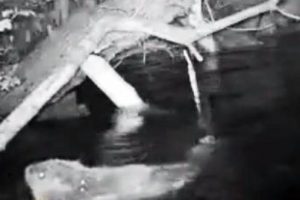
Wild beavers in Highlands must be captured
Animal trappers have been told they must capture a colony of beavers living wild on the banks of a Highland river.
A mother and two kits were found by Trees for Life, which promotes reforesting in the River Beauly area. But when the charity asked the Scottish government whether the colony could be rehomed in a wilder area, Roseanna Cunningham, the environment secretary, ordered Scottish Natural Heritage (SNH) to track the animals down and remove them.
The charity said it was disappointed by the decision because the government appeared to be unwilling to consider other options. One of Scotland’s leading conservationists, Sir John Lister-Kaye, who has a small estate on the river, agreed that the beavers — whose species had been extinct in the wild until recently — should not be brought into captivity.

The Scottish government said the beaver family must be removed from the Beauly
Beaver populations in Scotland are carefully controlled to placate the fears of landowners and farmers, who blame the animals for flooding prime agricultural land by building dams. There are only two established settlements: an official reintroduction in Argyll and an unofficial colony on the banks of the Tay in Perthshire.
Last month Trees for Life discovered the family of beavers living in the Beauly river system, a few miles west of Inverness. Camera footage shot by the charity showed two young kits swimming and playing with their mother on the banks of the river.
The charity shared the news with SNH, hoping that the animals would either be allowed to stay or be relocated locally. However, after being informed of the find by SNH, Ms Cunningham decided that the animals should be captured and placed in captivity before any release was considered, because she said they were likely to have been introduced into the area illegally.
Alan McDonnell, conservation projects manager at Trees for Life, said: “It is disappointing that the government is already starting the process of trapping this family without considering other options.
“While we understand that the minister wants to address the concerns of landowners in Tayside, the situation here is very different and we think it is possible to consult and negotiate with landowners in the immediate vicinity of the family and upstream to find an alternative outcome for the animals.”
It is disappointing that the government is already starting the process of trapping this family without considering other options
Last year, the Scottish government said that the colonies in Argyll and Tayside would be protected and allowed to remain in the wild even though the Tayside group was released illegally or had escaped from a private collection. The Tayside population is now estimated at more than 175 and extends from Kinloch Rannoch and Kenmore in the north and west to Forfar and Bridge of Earn in the east.
However, Ms Cunningham warned that any further unauthorised releases would be treated as a criminal act and said that the species would be “actively managed”.
Although Trees for Life insists that it is not yet possible to confirm whether the beavers were introduced illegally to the Beauly area, Ms Cunningham said: “We have been clear that we are minded that beavers can remain in Scotland and that their range can expand naturally.
“But the unauthorised release of beavers is a criminal offence and will damage the beaver reintroduction project. That is why I am asking SNH to take swift action in the Beauly area. We must avoid a repeat of the experience on Tayside.”
Sir John, who runs the Aigas wildlife centre on the River Beauly and is a former chairman of SNH, said that the animals had lived in the area for many years without causing any problems.
“They have not necessarily been introduced illegally,” he said. “They could be escapers from a centre or a private collection. It would be a real pity if they were removed. They’ve been here for five or six years and I have never heard one complaint made against them.”
He added that the majority of farmland in the area was used for livestock farming as opposed to arable farming so the beavers were unlikely to cause problems for farmers.
